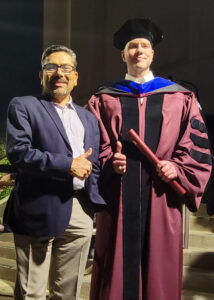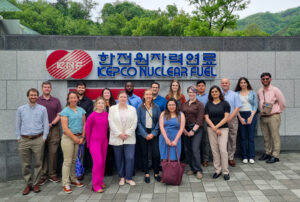
Current thermal neutron detection systems often rely on helium-3, a scarce and increasingly expensive resource. Moreover, helium-3 detectors operate under high pressure and require high applied voltages, complicating logistics and deployment. Center for Nuclear Security Science and Policy Initiatives (NSSPI) student Dr. Nicholas Wehmann’s doctoral research explored innovative alternatives to conventional neutron detection technologies by investigating the use of solid-state semiconductor thermal neutron detectors—specifically, DominoTM detectors. His work combined experimental measurements and MCNP simulations to assess the feasibility and performance of these detectors in future neutron detection systems. According to his advisor, former NSSPI Director Dr. Sunil Chirayath, “One of the important investigations Nick conducted was the use of multiple DominoTM detectors in a coincidence neutron detection system.”
In contrast to current detectors that rely on helium-3, the semiconductor detectors Wehmann investigated are low-cost, mass-producible, and eliminate the need for pressurized gas and high voltage, while offering flexible geometric configurations and significantly faster response times.
“The semiconductor detectors also have a faster response time to thermal neutrons which gives an improvement over the response of helium-3 tubes,” says Wehmann. “They represent a promising step forward in practical neutron detection technology.”
Wehmann earned his Ph.D. in Interdisciplinary Engineering with a graduate certificate in nuclear security at this past weekend’s graduation ceremony. Even though he was a remote student who completed his degree while employed at Los Alamos National Laboratory, he was still able to participate in many activities open to NSSPI students who pursue their degrees in person. Reflecting on his time at NSSPI, Wehmann highlights his participation in the International Nuclear Facilities Experience (NFE) trip to the Republic of Korea in April 2024. This immersive program gave him the opportunity to witness applications of international nuclear safeguards and security practices firsthand.

“During this trip I got to apply the knowledge I had gained in class and witness how other countries apply nuclear security and safeguards in real-world environments,” he explains. “During this trip I made connections with other attendees, including other NSSPI students as well as students from other universities and professionals in the field. Now a year later these connections are still holding strong, providing a nationwide professional network across various fields related to nuclear security and safeguards.”
Wehmann holds both a B.S. and M.S. from Oregon State University in Radiation Health Physics with minors in Political Science and Environmental Safety and Health. He has worked in multiple areas of Health Physics, including internal and external radiation dosimetry, operational health physics, radiation instrumentation, and emergency response. He currently works as a Health Physicist at Los Alamos National Laboratory, where he provides radiation protection support for weapons facility operations.